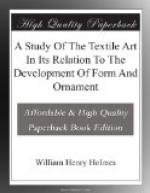Fig. 301 illustrates the simplest form of what Dr. O.T. Mason has called the twined combination, a favorite one with many of our native tribes. The strands of the woof series are arranged in twos and in weaving are twisted half around at each intersection, inclosing the opposing fillets. The resulting open work has much the appearance of ordinary netting, and when of pliable materials and distended or strained over an earthen or gourd vessel the pattern exhibited is strikingly suggestive of decoration. The result of this combination upon a lattice foundation of rigid materials is well shown in the large basket presented in Fig. 302. Other variants of this type are given in the three succeeding figures.
[Illustration: Fig. 303. Surface effect in impacted work of twined combination.]
The result seen in Fig. 303 is obtained by impacting the horizontal or twined series of threads. The surface is nearly identical with that of the closely impacted example of the preceding type (Fig. 292). The peculiarities are more marked when colors are used. When the doubled and twisted series of strands are placed far apart and the opposing series are laid side by side a pleasing result is given, as shown in Fig. 304 and in the body of the conical basket illustrated in Fig. 307.
[Illustration: Fig. 304. Surface effect obtained by placing the warp strands close together and the woof cables far apart.]
[Illustration: Fig. 305. Surface effect obtained by crossing the warp series in open twined work.]
In Fig. 305 we have a peculiar diagonally crossed arrangement of the untwisted series of filaments, giving a lattice work effect.
[Illustration: Fig. 306. Decorative effects produced by variations in the radiate or warp series in an open work tray. Klamath work—1/4.]
Fig. 306 serves to show how readily this style of weaving lends itself to the production of decorative modification, especially in the direction of the concentric zonal arrangement so universal in vessel-making arts.
The examples given serve to indicate the unlimited decorative resources possessed by the art without employing any but legitimate constructive elements, and it will be seen that still wider results can be obtained by combining two or more varieties or styles of binding in the construction and the embellishment of a single object or in the same piece of fabric. A good, though very simple, illustration of this is shown in the tray or mat presented in Fig. 286. In this case a border, varying from the center portion in appearance, is obtained by changing one series of the filaments from a multiple to a single arrangement.
[Illustration: Fig. 307. Conical basket of the Klamath Indians of Oregon, showing peculiar twined effect and an open work border—1/8.]
The conical basket shown in Fig. 307 serves to illustrate the same point. In this case a rudely worked, though effective, border is secured by changing the angle of the upright series near the top and combining them by plaiting, and in such a way as to leave a border of open work.




